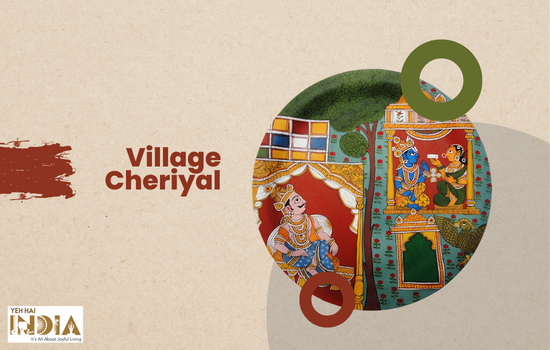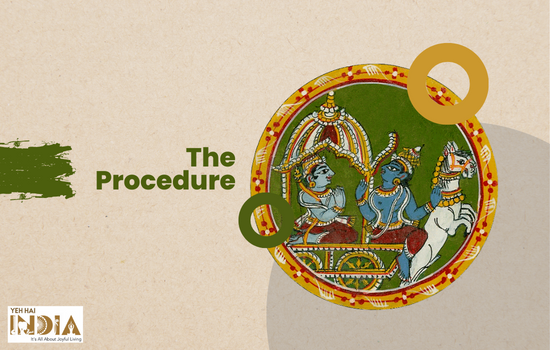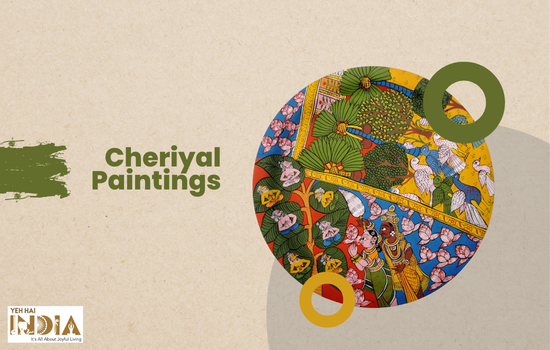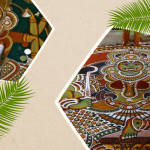Cheriyal paintings have a long history that can be viewed in its breathtaking motifs and patterns showcasing the lives of rural folks in Telengana.
Scroll paintings are a trademark of South Asia that evolve into distinct styles as you move from country to country. India, the land of diverse cultures, is proud of not one but multiple scroll paintings in various parts of the country.
Rajasthan, Maharashtra, Orissa, Bengal and Gujarat all have their own styles of scroll paintings depicting various themes and stories.
But Cheriyal paintings, also known as Cheriyal scrolls, are a form of traditional art originating in the village of Cheriyal in Telangana, India.
These paintings are known for their vibrant colors and intricate details, and typically use a scroll format to depict short religious stories from the Puranas and the Hindu Epics.
Despite the abundance of scroll painting traditions in India, Cheriyal Paintings are influenced mainly by local art traditions of Telangana, especially the temple art in the region. Kalamkari art is also a major influence on Cheriyal paintings.
The Origin of Cheriyal Paintings:

As it was mentioned before, scroll paintings have always been popular in South and South East Asia. In China, scroll paintings were restricted to the nobility but in India, they were a tradition of the storytellers: bards and artists.
Villages in India developed their own scroll painting traditions. Cheriyal paintings took influence from the local temple art traditions and Kalamkari traditions.
The graphic art traditions across the Deccan and South India also had influence over this art form which developed in Telangana in particular.
The history of Cheriyal painting can be traced back to the 18th century, when the village of Cheriyal was a thriving center of art and culture.
The scrolls were originally used as a teaching tool in temples and schools, and they were created using natural materials such as plant dyes and mineral pigments.
Over time, the art form evolved and the scrolls began to depict a wider range of subjects, including historical events, social issues, and everyday life.
Today, Cheriyal scrolls are still used to educate and tell stories, but they are also highly sought after by collectors and museums around the world.
Recommended Story – Exploring Kalighat Paintings Of Kolkata
Characteristics of Cheriyal Paintings:

One of the most striking features of Cheriyal paintings is use of vibrant colors. The artists use a wide range of hues, including deep reds, bright greens, and rich blues, to create striking and vivid images.
The colors are derived from natural materials, such as plants, minerals, and insects, and they are carefully mixed and blended to create the desired effect.
In terms of composition, Cheriyal paintings are characterized by their intricate details and highly stylized figures. The figures are typically elongated and slender, with elongated limbs and exaggerated facial features.
The artists use a variety of techniques to create the illusion of depth and movement, including the use of perspective and shading.
One of the most interesting aspects of Cheriyal painting is its use of the scroll format. The scrolls are typically created on long strips of paper or cloth, and they can be unrolled to reveal the entire painting.
This allows the artist to create a narrative that unfolds over time, and it also makes the paintings highly portable and easy to display.
In terms of subject matter, Cheriyal paintings can depict a wide range of themes and ideas. As mentioned earlier, the scrolls were originally used to tell religious stories, but today they are used to depict a wide range of subjects.
Some common themes include historical events, social issues, and everyday life.
Despite their long history and cultural significance, Cheriyal paintings are not as well known as other Indian art forms, such as Rajput miniatures or Mughal miniature paintings.
However, they are highly prized by collectors and museums around the world, and they continue to be an important part of Indian art and culture.
The Procedure:

The process of creating a Cheriyal painting begins with the selection of the paper or cloth on which the painting will be created. The artists typically use a long strip of paper or cloth, which is then stretched out and secured to a flat surface.
The artists begin by sketching out the basic outlines of the figures and scenes, using a pencil or charcoal.
Once the basic outlines are in place, the artists begin to add color to the painting. As mentioned earlier, the colors used in Cheriyal paintings are derived from natural materials, and they are carefully mixed and blended to create the desired effect.
The artists typically use a variety of brushes and applicators, including fine-tipped brushes for detailed work and larger brushes for filling in larger areas of color.
As the painting progresses, the artists continue to add details and refine the composition. This can involve adding additional layers of color, adding highlights and shadows, and carefully blending the colors to create a smooth and seamless effect.
The artists may also add gold or silver leaf to the painting to create additional visual interest and depth.
Cheriyal paintings are available only in their namesake town. Although earlier, they could be found all over Telangana, the advent of mass produced art has reduced its popularity.
The paintings themselves have changed to adapt to modern times by becoming shorter and more amenable to being framed in houses or other creative spaces.
In times like this, it is up to us to opt for true artistry like those contained in Cheriyal Paintings and to keep the precious traditions of India alive.
With scroll painting art taking a new twist, it’s worth taking note of the Cheriyal scroll art to understand its relevance in terms of culture and ethnicity to help them sustain in the modern world.
Also Read – 10 GI Protected Paintings Of India











Really a Great Paintings.Thanks a lot for sharing